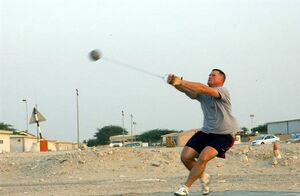The Hammer Throw
Original Editor - Matt Huey
Top Contributors - Matt Huey, Kim Jackson and Vidya Acharya
Introduction[edit | edit source]
The hammer throw is an event in which the participant throws a weighted ball on a steel wire for distance. The legend of the origin of the hammer throw go back to around 2000BC when a Celtic warrior, Culchulainn picked up a chariot axle and wheel and threw it during the Tailteann Games in Tara, Ireland. There are also drawings from the 16th century showing people throwing blacksmith's hammers.
The hammer has been apart of the Olympic games since 1900 for men and in 2000 for women.
The Hammer[edit | edit source]
The hammer consists of a metal ball attached to a length of wire with a handle at the top. For men, the hammer weighs 16lbs (7.26 kg) and is on a 3 ft 11.75 in (121.3cm) wire. For women, the hammer weighs 4kg (8.82lbs) and is on a 3ft 11in (119.4cm) wire.
Both men and women competitors make their throw from inside a ring which is 7 ft (2.135m) in diameter into a sector which is 34.92 degrees from the center of the throwing ring.
Rules[edit | edit source]
- Competitors cannot enter the circle until their name has been called
- The competitor generates a centripetal force by turning their body then release the hammer into the sector
- Once the hammer has landed in the sector the command "mark" is given to which the competitor exits the ring
- A measurement is recorded from the inside of the ring to the mark at which the hammer landed
Fouls are called if the competitor performs any of the following violations
- Enters the ring before name being called
- Any portion of the competitor (including clothing) touching the top or outside of the ring
- The hammer landing outside the sector
- Exiting the ring before the "mark" command
- Exiting the ring from the front half of the circle
Technique[edit | edit source]
Competitors start at the rear of the ring where they swing the hammer back and forth to generate momentum. Then the competitor will make rotations in a heel-toe foot movement going towards the front of the ring. They may make anywhere from three to five rotations. They are generating centripetal force as they turn while increasing the angular velocity of the hammer. This allows the competitor to release the hammer on an upward trajectory into the sector.
Records[edit | edit source]
| Division | Athlete | Distance |
|---|---|---|
| Men's | Yuriy Sedykh | 86.74 m (284 ft 6 in) |
| Women's | Anitia Woldarczyk | 82.98 m (272 ft 2 in) |
Common Injuries[edit | edit source]
Knee injuries can occur due to the rotational forces put on the knees during the throw. Back injuries can also occur due to the rotation of the body during the release portion of the throw[1].
References[edit | edit source]
- ↑ Meron, A., & Saint-Phard, D. (2017). Track and Field Throwing Sports: Injuries and Prevention. Current sports medicine reports, 16(6), 391–396. https://doi.org/10.1249/JSR.0000000000000416







